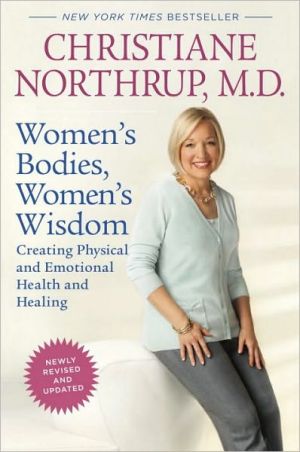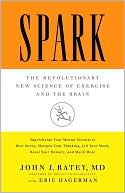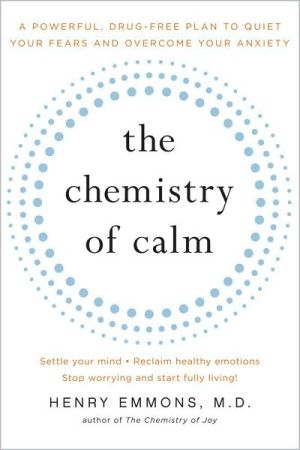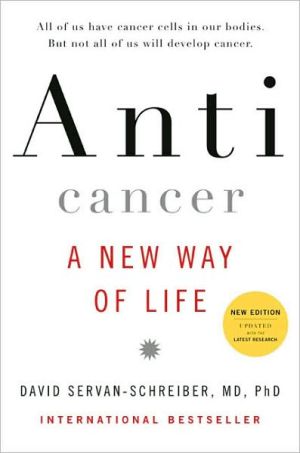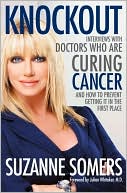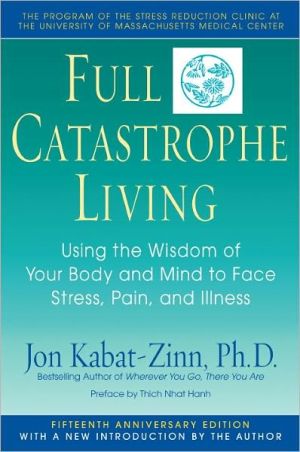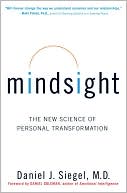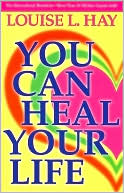Women's Bodies, Women's Wisdom: Creating Physical and Emotional Health and Healing
When it was first published in 1994, Women’s Bodies, Women’s Wisdom quickly became an international bestseller, and for the past fifteen years it has remained the veritable bible of women’s health. Now, in this revised and updated edition, world-renowned and much-beloved women’s health expert Dr. Christiane Northrup shares with us the latest developments and advances that will maximize our potential for living well in our bodies today. Inside you will discover\ \ • new material on...
Search in google:
Dr. Christiane Northrup’s vision of mind-body wellness has received an extraordinary response from women all over the world. Her groundbreaking classic, Women’s Bodies, Women’s Wisdom, powerfully demonstrates that when women change the basic conditions of their lives that lead to health problems, they heal faster, more completely, and with far fewer medical interventions.Here in this revised edition is the most up-to-date information available on the entire range of women’s health concerns, including:• A nutrition chapter emphasizing individual dietary needs and body chemistry• Information on improving fertility after age 35–and how to cut the risk of C-section by 50 percent• A comprehensive program for menopause, including how to decide whether natural hormone replacement is right• Holistic ways to prepare and heal faster if surgery is necessary• Plus dozens of natural treatments and a wealth of hard-to-find health care resourcesFilled with dramatic case histories from her medical practice in Maine, Women’s Bodies, Women’s Wisdom is contemporary medicine at its best, combining new technologies with natural remedies and the miraculous healing powers within the body itself. Publishers Weekly This guide goes far beyond standard self-help books [and] is as accessible as it is empowering.
Speaking Our Truth\ \ During the month after this book was initially published, I had a series of nightmares that someone was in my bedroom about to kill me. For five consecutive nights I woke up screaming in terror, scaring my children as well as myself. My dreams were my not-so-subtle inner guidance system letting me know how terrified a part of me was to actually put what I knew out into the world. I was shocked by the power of this fear. Though I'd known intellectually that many women have a wall of fear within them that arises when they dare to speak their truth, I hadn't realized how much of that fear I also shared. I dreaded going to the hospital for the regular OB/GYN meeting in June 1994, after the book went on sale, because I was sure that my colleagues would reject me and my work. Until then I had lived a professional double life: One part of me told patients what I really believe, in the privacy of my personal office, and the other part, the "official" me, held back a bit (or a lot) in the hospital or around many colleagues.\ My socialization as a doctor had taught me well what was acceptable to my colleagues and the hospital staff. I'd been treading a fine line for years. In fact, back in 1980, right after the birth of my first child and before I took my oral exams for board certification in OB/GYN, I was featured in a cover story on holistic women's health for East West Journal (now Natural Health). In order to ensure that nobody at the hospital where I worked saw the article, I went to the co-op where East West was sold locally and personally purchased all the copies there. No one at my hospital ever saw it—or if anyone did, they never said anything about it. But in 1994, it was not going to be possible to purchase every copy of a mass-marketed book! I had to face the music and bring the two parts of myself together publicly—and in front of conventional medical groups—for the first time.\ My first step was to go to my weekly hospital meeting. When I walked in, I was relieved when almost no one said anything about the book and I wasn't treated any differently. It was as though nothing had happened. I had to laugh, for at that moment I learned a lesson about self-centeredness—believing that everyone around me is interested in what I'm doing or saying, when in fact they have their own lives to live. My biggest lesson was that my fear was just that . . . all mine, and it was time to let it go. This has been a gradual process: On the book's first anniversary, I had a series of dreams in which someone was videotaping me naked. I was still feeling vulnerable, but at least I wasn't about to be killed! Since then, the dreams have gradually disappeared.\ Since 1994, I've been invited to speak to hospital staffs and doctors all over the country and abroad, and I have received an overwhelmingly positive and heartwarming response from women and men in the United States and around the world. Clearly, the world is ready for women's wisdom. The comment I hear most often, from women, men, and even many doctors, goes something like this: "Somewhere deep within me, I've always known the truth of what you were saying . . . but I didn't have words for it. And I certainly had never heard a doctor say it."\ I have come to see that medical science, when combined with the wisdom of our hearts and our minds, is powerful medicine indeed. And that's why, almost as soon as this book was published, I found myself itching to revise it. Though there is no replacement for developing and honing our intuitive women's wisdom—that inner guidance that helps us choose which roads to take and which ones to avoid—I've found that this inner guidance works best when it's balanced with good, solid, up-to-date information.\ And though the principles of true wisdom don't change much over time, useful and practical information does. We need both—just as we need both our left and right brain hemispheres. And with the burgeoning acceptance of alternative medicine into mainstream culture (a phenomenon that still surprises and delights me), more and more scientifically documented natural solutions to women's health problems become available every day. Simultaneously, good technological solutions, such as new devices to help stress urinary incontinence, as well as better surgical techniques to remove fibroids, are also helping many women. And each time I have updated my thinking and my recommendations, I have wanted to get that new information out to my readers so that they too can use it to improve their lives and their health.\ In addition to adding better and more timely solutions to each section of the book, I found it necessary to completely rewrite the chapters on nutrition and menopause because there is so much new and helpful information in these areas, ranging from how to individualize a hormone replacement regimen using hormones native to the female body to how to find a dietary approach that balances both your brain and body biochemistry. Women's health is finally getting the attention it deserves, and as a longtime player in this field, I have a great deal to say and a lot of new information to share.\ By sheer serendipity, my newsletter, Health Wisdom for Women, was launched in partnership with Phillips Publishing International several months after the first edition of this book came out. So now, instead of addressing the problems of twenty women in my office each day, I am able to reach thousands every month. In essence, the health care solutions offered through the newsletter, together with my subscribers' correspondence and feedback, have become a virtual practice. This has allowed me to keep my finger on the pulse of women's health care in a much broader and more diverse way than ever before. I've also heard from countless physician colleagues, who tell me that patients often bring in either a copy of Women's Bodies, Women's Wisdom or the newsletter to discuss a particular approach that I've recommended. Most of these doctors are grateful for the information. This grassroots approach truly appeals to my small-town origins.\ Writing the first edition of Women's Bodies, Women's Wisdom opened up to me a larger world of women's wisdom that is growing all over the planet. Because of this, I have more support from more people and places than I ever dreamed possible. This has allowed me to become more of who I really am. I know from all the letters I receive that the same thing is happening to others across the globe. The original book is being used as a text in nursing schools and hospitals around the country—and this helps women's wisdom gather steam and momentum.\ I've learned the power of telling my personal truth. It has been a very significant part of my healing process. And I have emerged feeling stronger and freer than ever before. I hope this book will inspire other women to speak their personal truths, too. I know that as each of us does this, the world—and our health—changes for the better.\ \ Chapter twelve: Pregnancy and Birthing\ My Personal Story\ As a mother and a women's doctor, I have experienced childbirth from both sides of the bed. Every mother has moments that she cherishes from the birth experience and insights and feelings she'd like to share with other women. I'd like to tell you my story and also some remarkable stories of other women.\ The due date for my first child was December 7, 1980. I continued my work supervising the residency clinic at a Boston hospital, and I flew or drove to Maine every other week to keep my practice going there. I had watched far too many pregnant women stop work early and then mope around the house eating, waiting for the baby to come, sometimes begging their obstetrician to induce labor. I didn't want to fall into that category. I had also seen dozens of women go overdue. I certainly wasn't going to get excited about labor—at least, not until my due date.\ On Thanksgiving we went to dinner at a friend's house. Later that evening, back home in bed, I started to experience very mild but regular contractions that didn't hurt. Like the good controlled doctor that I was, I went into the bathroom and decided to examine my cervix to see if I was dilating. When I did this, my water broke. I thought, "Damn, now I know this really is it." Shortly thereafter, without the natural "padding" that the amniotic fluid provides, my contractions began coming every two minutes and were much more uncomfortable than initially.\ I called my mother, who was planning to help me after the birth and said, "I'm not going to like this." She said that she understood (after six children, she knew) but that it wouldn't last forever. In the 1940s, Mom had always had to labor alone, strapped down in bed with no pain relief or personal support. For each delivery, she had been knocked unconscious by drugs and was handed the baby later by the obstetrician, as though it were a gift from him and not the fruit of her own labor. Thousands of women like her were never given a choice and didn't even know there were other ways to deliver.\ The pain of labor was far greater than I thought it would be. (It's always worse after the membranes are ruptured, a point that doesn't seem to stop some obstetricians from doing it prematurely even when there's no need to.) I had seen hundreds of women in labor after five years of OB training. I had always focused on the women who didn't appear to have any discomfort, and I was so sure I would be one of them. But here I was—stuck. I felt as though I were in a box, and there was no way out except through. My intellect could not get me out of this—and I was determined to go through the process naturally. I already trusted the natural world more than the artificial man-made one. What I didn't appreciate then was the depth of my own programming into and cooperation with that same man-made world.\ We called my obstetrician, a sensitive man with whom I had worked in the hospital for several years. He suggested that my husband and I go into the hospital. The only problem was that all I wanted to do was stay on the floor on my hands and knees. Moving anywhere seemed to me the most unnatural thing I could think of. It went against every instinct in my body.\ I didn't have a bag packed for the hospital, so my husband ran around and put some underwear, a nightgown, and a toothbrush in a bag. Then he tried to get me dressed, out the door, and into the car. He nearly had to carry me. Left to my own instincts, I would never have left my position on my hands and knees on the floor.\ When we got to the hospital, a place where I had worked for half a decade, I had to go through the admitting office as a patient. Admissions had lost the correct papers and would not let me go upstairs to the labor and delivery floor, where my nurse friends and my doctor were waiting. This was my introduction to the bureaucracy of hospitals, something I'd been shielded from for years. (Laboring in a hospital hallway alone is inhumane; but for thousands of women, it is their experience.) I simply walked out of that room, went to the back hall elevator, got in, and went up to labor and delivery by myself.\ When my doctor examined me, I was four centimeters dilated. (You have to get to ten to be ready to push.) For the next three hours my contractions came frequently. But I failed to dilate beyond six centimeters, where I remained "stuck" for those three hours. The contraction pattern on the monitor was "dysfunctional." Though the contractions hurt a lot, and I never got much of a break between them, they simply were not getting the job done. I had what is known as hypertonic uterine inertia, which means that the contractions, though present, are not efficient—they are erratic, originating all over the uterus at the same time, like the heart when it goes into atrial fibrillation. (The high heart—in the chest—does the same sort of thing as the low heart—the uterus in the pelvis—sometimes.) Instead of beginning at the top and moving in a wave to the bottom of the uterus, the contractions originated in many places at the same time. Labor didn't progress well. It was like trying to get toothpaste out of a tube by squeezing it in fifteen places at the same time with a little bit of pressure, instead of squeezing firmly only at the back end of the tube so that the paste comes out uniformly.\ When my doctor told me that I had made no progress in three hours, I knew what was next. (Remember, my intellect thought it was in control of my labor.) "Okay," I said, "start the IV, plug in the fetal electrode, and hang the Pit." Pitocin (oxytocin) is a drug that artificially contracts the uterus. After the Pitocin was started, the contractions became almost unbearable, going to full intensity almost as soon as they started.\ No amount of Lamaze breathing distracted me from the intensity of the feeling that the lower part of my body was in the grip of a vise. At one point, I looked at the clock and saw that it was 11:15 A.M. What I recall thinking was, "If this goes on for another fifteen minutes, I'm going to need an epidural anesthetic." I didn't know that I was in transition—the part of labor that is most intense, just before the cervix becomes fully dilated. Within the next twelve minutes I suddenly felt the urge to push. It was the most powerful bodily sensation I've ever felt, and I was powerless to resist it. The thought flashed through my mind, "If I ever tell another woman not to push when every fiber in her body tells her to push, may God strike me with lightning!"\ In two pushes, Ann almost flew out of my body. My obstetrician quite literally caught her. Though I was laboring in the "birthing room," I wasn't laboring in the "correct" delivery bed, and I barely made it to the delivery bed in time. (Birthing rooms now are equipped with beds that adjust for delivery of the baby, so that moving from one bed to another isn't necessary.)\ Ann cried and cried, and though I put her to my breast almost immediately, it still took quite a while to calm her down. I believe this was because the Pitocin made for a far too rapid second stage of labor. It was too intense both for Ann and for me. Neither she nor I had much chance to recover between contractions.\ A primiparous patient—one having her first baby—usually takes an hour or more to push the baby out. From the time the cervix is fully dilated to delivery—the second stage of labor—I went from six centimeters to delivery in less than one hour; my uterus was being pushed by a powerful drug, a very intense and distinctly unnatural experience.\ To this day, my daughter is not particularly "at home" in her body and is afraid to take physical risks, for instance in skiing or hiking. Though there are various reasons for this, I know deep within me that being propelled into the world with so little time to accommodate herself to the process of labor was a terrifying experience for her.
List of FiguresList of TablesAcknowledgmentsIntroduction to the Revised Edition: Speaking Our TruthIntroduction to the First Edition: Physician, Heal Thyself1The Patriarchal Myth and the Addictive System32Feminine Intelligence and a New Mode of Healing253Inner Guidance504The Female Energy System675The Menstrual Cycle1016The Uterus1647The Ovaries2108Reclaiming the Erotic2419Vulva, Vagina, Cervix, and Lower Urinary Tract25910Breasts32711Our Fertility38112Pregnancy and Birthing44513Motherhood: Bonding with Your Baby49514Menopause51515Steps for Healing57916Getting the Most Out of Your Medical Care64217Nourishing Ourselves with Food67418The Power of Movement74019Healing Ourselves, Healing Our World757AppChoices in Hormone Replacement777Resources787Notes831Index891
\ Publishers Weekly - Publisher's Weekly\ This guide goes far beyond standard self-help books [and] is as accessible as it is empowering.\ \ \ \ \ Library JournalWhile this book offers a great deal of sound and sympathetic advice about healthy living for women, it is accompanied by an excess of feminist rhetoric and New Age mumbo jumbo. (Do fibroids really "result when we are flowing life energy into dead ends, such as jobs or relationships we have outgrown''?) The reader might feel more comfortable skipping those parts of this otherwise excellent work. Northrup, the founder of a women's health clinic in Maine, takes up women's standard health problems and offers spiritual and philosophical counsel along with suggestions on dietary change, confronting one's feelings about disease, visualization practices, and other holistic remedies. Although much of this same advice can be found elsewhere, Northrup's approach is more casual. For example, she feels that the main reason for exercise should be that you enjoy it. \ -- Natalie Kupferberg, Montana State University Library, Bozeman\ -- Mark Guyer, Stark City District Library, Canton, Ohio\ \ \ Library JournalWhile this book offers a great deal of sound and sympathetic advice about healthy living for women, it is accompanied by an excess of feminist rhetoric and New Age mumbo jumbo. (Do fibroids really "result when we are flowing life energy into dead ends, such as jobs or relationships we have outgrown''?) The reader might feel more comfortable skipping those parts of this otherwise excellent work. Northrup, the founder of a women's health clinic in Maine, takes up women's standard health problems and offers spiritual and philosophical counsel along with suggestions on dietary change, confronting one's feelings about disease, visualization practices, and other holistic remedies. Although much of this same advice can be found elsewhere, Northrup's approach is more casual. For example, she feels that the main reason for exercise should be that you enjoy it. \ -- Natalie Kupferberg, Montana State University Library, Bozeman\ \ \ \ \ BooknewsNew edition of a guide to women's physical and emotional well-being. Supports the viewpoint that when women change the basic conditions of their lives, they heal faster and more completely. Contains updated information on a range of subjects organized into three major sections -- from external control to inner guidance, anatomy, and how to integrate the best techniques of Western medicine with alternative therapies.\ \ \ \ \ WomanSource Catalog & Review: Tools for Connecting the Community for WomenThrough her clinical and personal experiences, Dr. Christiane Northrup came to see that negative circumstances in our lives often manifest themselves in our bodies as illness and pain. In Women's Bodies, she addresses each area of women's health and explains the potential problems that can arise, the possible treatments and the ways that each can be affected by a women's spiritual and emotional status. Examples from the lives of her patients illustrate how changes in attitude and life situations can affect a woman's health. She also gives advice on choosing a doctor, deciding on a treatment, nourishing ourselves and healing emotional scars. Christiane serves as an example of a doctor who has taken her conventional medical training and expanded it to address all aspects of health.\ —FGP\ \
